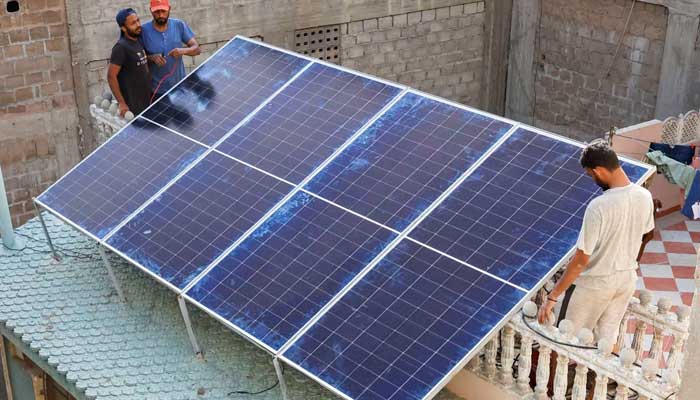
Pakistan’s energy consumption has seen notable changes in recent times, with many consumers turning to solar energy, including the country’s agricultural sector, where rows of solar panels have become a new norm.
The increasing trend of solarization is reflected in data compiled by BloombergNEF which shows that imports of solar equipment from China in the first nine months of the current year are much higher than those of the whole of 2023.
The $1.7 billion in purchases, according to the Bloomberg report, would be equivalent to 17 gigawatts of electricity generation, or more than a third of Pakistan’s total electricity capacity if all of this was deployed on rooftops and farms across the country.
For corn farmer Mohammad Murtaza, installing the panels allowed him to reduce his electricity bill by replacing irrigation pumps with diesel or costly electricity from the grid.
Farmers like him are the latest to join the solar energy craze, after households and factories, in a country where electricity prices for some have tripled since 2021, as the government has reduced subsidies to respond International Monetary Fund lending requirements.
This unrestrained solarization has several advantages. Including financial assistance to consumers and businesses who can afford the panels.
While this will save the government money on fuel imports, it will help Pakistan achieve its goal of doubling renewable energy to account for 60% of the energy mix by the end of the decade.
However, this rapid, unregulated boom also threatens to weaken the country’s public services and destabilize the fragile economy.
“There is a big rush for solar energy in Pakistan: the numbers are staggering,” said Muhammad Mujahid, executive director of Innovo Corporation, a panel distributor based in Lahore.
But it also creates the “risk of a death spiral in public services,” he added.
As many customers reduce their consumption of the grid, or even abandon it altogether, Pakistan’s power companies are permanently losing a significant share of demand and revenue.
Utilities racked up losses of 2.4 trillion rupees ($8.6 billion) between 2014 and 2023, according to government data. The IMF said maintaining demand should be a key objective of reforms.
“Pakistani distribution companies are losing every day as solar energy becomes attractive,” said Salahuddin Riffai, who served as chairman of Islamabad Electric Supply Co until 2022.
“The burden continues to increase for the customers who remain,” notes Riffai.
The country was already in financial trouble after borrowing heavily from China under the Belt and Road Initiative over the past decade to boost its power generation capacity.
Pakistan is currently in negotiations to try to extend the maturities of this debt. The government is also in talks with local power producers to revise or terminate purchase contracts and is considering privatizing some utilities to reduce costs.
“If the government opens the electricity market without capping solar capacity, most of the current generation fleet will go unused,” said Syed Faizan Ali Shah, who sits on the prime minister’s solarization committee.
“So who is going to pay for these power plants? This is a major concern,” he warned.
The flood of solar panels from China began in 2023 and turned into a deluge after Pakistan removed import restrictions late last year, making it the third destination of Chinese panels, according to BNEF. They are now advertised on billboards in major cities and during cricket matches.
The frenzy has not been limited to the energy sector as real estate companies and electronics companies have also started flipping panels, with the largest traders bringing in up to 250 megawatts every month, according to Usman Ahmad, CEO from the solar distributor Nizam Energy. Pvt.
Demand was driven by households and factories producing everything from cement to clothing, which have suffered frequent power outages in the past due to unreliable grid power.
Speculation that the grid will collapse is “extreme,” but reduced demand is indeed a concern, Energy Minister Awais Leghari said in an interview.
Utilities “need to be a little more responsive to customer demands in terms of reliability and rates, he said, adding: “We all realize that the status quo cannot prevail.”
